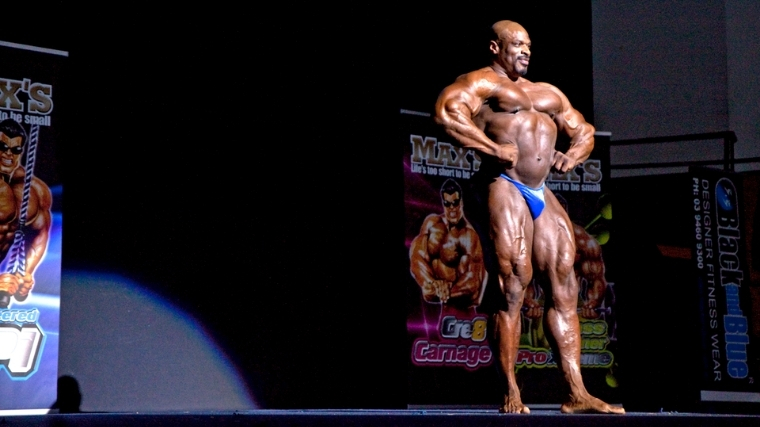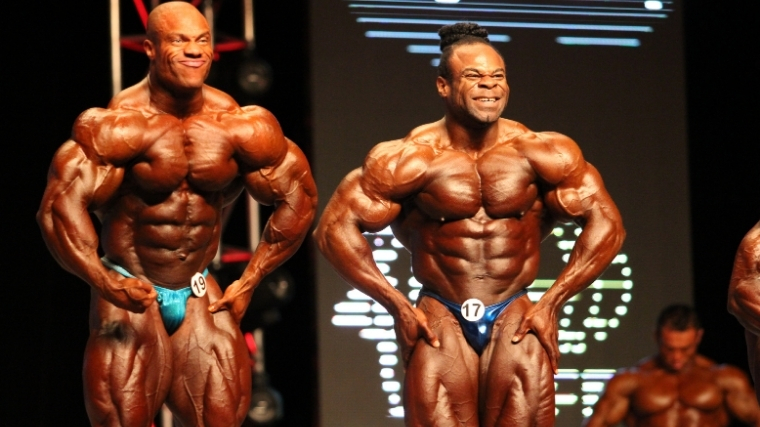Bodybuilding is unlike any sport in that it may just be the most subjective and, therefore, the hardest to judge. In ball sports, you know who’s winning based on how many points a team has. Combat sports judge the winner based on damage taken versus damage given. But how do you fairly and accurately score a bodybuilding contest?
There is a scoring system in place, which we’ll go over below. However, judging a series of conditioned and muscular physiques is challenging, especially when the competitors themselves keep evolving.
From the 1950s to the 1980s, bodybuilders sought out more trim, aesthetic bodies. Three-time Mr. Olympia winner Frank Zane (1977-1979), for example, stood 5’9” and weighed about 190 pounds. By comparison, last year’s winner Brandon Curry is two inches shorter and roughly 70 pounds heavier.
To appeal to more body types, the IFBB Professional League and National Physique Committee (NPC) have added new divisions — namely, Men’s Physique, Classic Physique, Women’s Physique, and Women’s Wellness. Each one appeals and favors a different body type (which we’ll also go over below). Here’s a breakdown of how the scoring system works and how each division is judged.
How Bodybuilding is Judged
Below are the main criteria that each judge focuses on when judging competitors in all divisions. Note: Different divisions have different standards, so the below points may not apply as much or at all to particular divisions. That said, these are the overarching aspects of what makes a physique — in any division — stand out from the rest.

Muscle Mass
A bodybuilder needs to have developed muscles. Otherwise, judges can’t accurately critique the shape and symmetry and conditioning. A large muscle has more visible separation and striations (visible muscle fibers that ripple when flexed). What’s more, athletes must ensure that the muscles are large but in the right proportions. A small upper chest and large lower chest may look unappealing, as do big quads paired with underdeveloped calves. The muscle must be all-around substantial.
Definition
On the flip, packing a ton of smooth, soft muscle mass isn’t going to win shows either. A winning physique is a sculpted physique. Typically, competitors want to come in at a body fat percentage around five percent — which is low enough to allow judges to see the grooves and texture of the actual muscle, as well as vascularity. Getting one’s body fat down this low requires months of rigorous macro-counting. Closer to competition, some competitors will begin to manipulate their water and carbohydrate intake (and in some cases even take diuretics) to drain as much water as possible from between their muscles and skin.
Symmetry and Balance
While size and definition are important factors, an unbalanced body has been the downfall of many prolific bodybuilders. Overpowering legs, underdeveloped biceps, or mismatched deltoids can all plague a bodybuilder’s overall aesthetic. Unfortunately, factors one can’t change, like limb length and muscle insertion points can also negatively affect proportions. Symmetry can be achieved through training to a point, but genetics play a role.
For example, Mike Matarazzo, an IFBB bodybuilder in the late 1980s, had a tremendous physique, but his long torso gave the illusion of a smaller chest and back compared to his massive quads. That doesn’t mean Mike wasn’t competitive — he won the 1991 NPC USA Championships and managed to place ninth in the 1998 Mr. Olympia, which is nothing to scoff at. All this to say, being able to honestly assess your physique is a must so you can create a workout program to bring up your weaknesses. Judges will notice even the slightest faults. It is, after all, their job.
A Word About Genetics
As implied above, genetics do play a considerable role in a bodybuilder’s success. Uncontrollable factors like the shape of a specific muscle, where that muscle sits on the body, and one’s frame are all important but cannot be trained. Eight-time Mr. Olympia Ronnie Coleman was undoubtedly a hard worker, but few human beings can achieve a physique that’s 298 pounds and sub-five percent body fat. At the highest level, where all competitors are up to snuff, genetics can be the winning (or losing) factor. Seven-time Mr. O Phil Heath was in part so dominant due to his near-perfect muscular symmetry and pleasing physique. One can train hard to get larger and more conditioned, but no one can train for a more appealing body. Your structure is your structure. And at the end of the day, the most aesthetic physique wins.
How Bodybuilding is Scored
According to ifbbpro.com, “Judges will score competitors according to the ‘total package,’ which is a balance of size, symmetry, and muscularity.” Because bodybuilding is seen as a subjective sport, the IFBB Pro League has developed a scoring system based on averages. Typically, seven judges rank the competitors. However, to achieve what the IFBB deems a fair average, each competitor’s highest and lowest scores are dropped. In the Mr. Olympia, competitors are ranked from one through 15 and everyone outside of 15th place is in 16th place. The lowest score is equal to the highest ranking in bodybuilding, so the competitor with the lowest overall score wins.
How Different Divisions are Judged
Different leagues offer different divisions, but we’re basing this list (and the criteria) on the NPC and IFBB Pro League. Each division has the competitors flex to show off their physique, but, depending on the division, those poses may be different. Also, what a judge is looking for out of a physique will change from division to division. Below is an explanation of how each specific division is distinct.
Men’s Open Bodybuilding/212
When people hear the word “bodybuilding,” this is the class of competitors they think of. The Men’s Open is comprised of the largest and most conditioned athletes. Size rules in this class. The 212 division is separate from the Open, as athletes must weigh less than 212 pounds to compete. However, the criteria and poses are the same.

Here are the eight mandatory poses that Open and 212 competitors must hit in judging:
- Front double biceps
- Front lat spread
- Side chest
- Back double biceps
- Back lat spread
- Side triceps
- Abdominals and thighs
- Most muscular
Classic Physique
In 2016, the National Physique Committee (NPC) and IFFB Pro League introduced the Classic Physique. This division favors physiques that harken back to the Golden Era of bodybuilding (in the 1960s to 1980s). There are a series of height and weight limits within Classic Physique. Judges look for mass, but more so conditioning and symmetry. Compared to the Open, competitors hit just five poses. (1) These poses are:
- Front double biceps
- Side chest
- Back double biceps
- Abdominals and thighs
- Favorite classic pose (no most muscular)
Men’s Physique
Men’s Physique competitors are judged on who has the most athletic-looking physique — based on shape and symmetry, combined with muscularity and overall condition. Also, stage presence and poise are factors, too. Athletes should appear confident. The competitors wear board shorts which cover their thighs. Instead of traditional bodybuilding poses, Men’s Physique competitors complete a series of quarter turns to show off their body from different angles.
View this post on Instagram
Wheelchair Bodybuilding
The WCBB (Wheelchair Bodybuilding) is an organization for competitors who use wheelchairs. It is a separate federation from the IFBB Pro League. However, athletes in this class can earn an IFBB Pro card and compete at the Olympia. Judges look at the musculature of the upper body, and competitors complete four mandatory poses. Another distinction is that athletes wear loose-fitting training pants instead of posing trunks. Here are the four mandatory poses that they are judged on:
- Front double biceps
- Side chest
- Back double biceps
- Abdominals
Women’s Bodybuilding
For the first time since 2014, Women’s Bodybuilding will make a return to the Olympia stage. Of all the women’s division, competitors in this class sport the most mass. They are judged on size, conditioning, and symmetry. They also hit the same poses as the Men’s Open/212 competitors, minus the most muscular.
Women’s Physique
Created in 2012, this division is very much like the Men’s Classic Physique in that aesthetics and shape are valued more than mass. Accordingly, the poses are similar to the men’s classic physique and have just five mandatory poses. They are:
- Front double biceps (with open hands)
- Side chest (with arms extended)
- Back double biceps (with open hands)
- Side triceps (with leg extended)
- Abdominals and thighs
Figure
Figure competitors don’t engage in posing like Women’s Physique competitors. Rather, they perform a series of quarter turns similar to how the Men’s Physique division is judged. In this division, women are judged heavily on balance and shape — specifically in the hamstrings, glutes, shoulders, and back. Judges don’t want to see the deep musculature and striations often found in Women’s Physique competitors.
Fitness
Women’s Fitness is the most dynamic competition in the sport. The competition has athletes compete to show off their physiques with a series of quarter-turns, and then they individually perform a dance-style routine that must include the following moves: Push-up, high kick, straddle hold, and side split.
View this post on Instagram
Bikini
Bikini competitors are judged on balance and shape, and overall appearance, including the hair, skin tone, complexion, and poise. Athletes first perform a “model walk” and then are compared by performing a series of quarter turns.
Wellness
The Wellness division won’t be featured in the Mr. Olympia until 2021, though it is a division in the IFBB Pro League and the NPC and is a part of the Amateur Olympia. Wellness is broken up into different height classes and focuses on judging mainly on “body mass in the hips, glutes, and thigh areas,” according to the IFBB Pro League. Compared to the other female divisions, this division focuses the least on muscle separation. They also are compared through a series of quarter turns.
Featured image: “Phil Heath Kai Greene” by Kevin Laval is licensed under CCO 1.0.